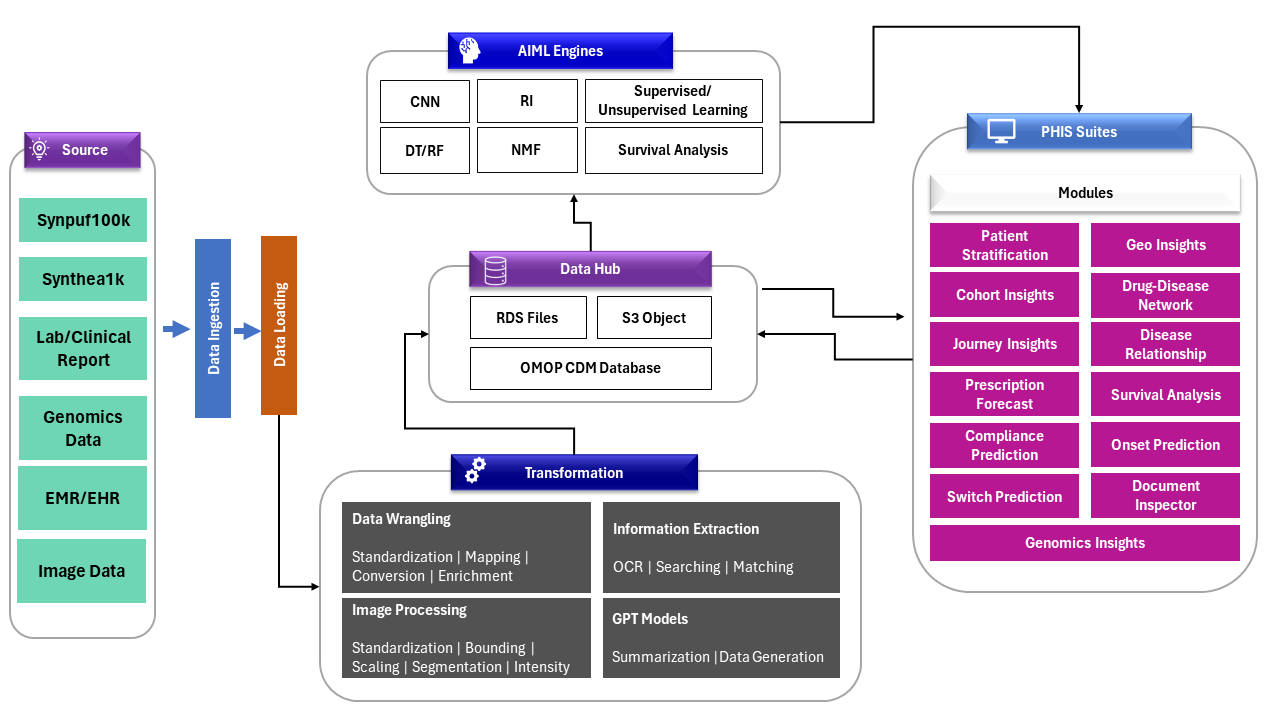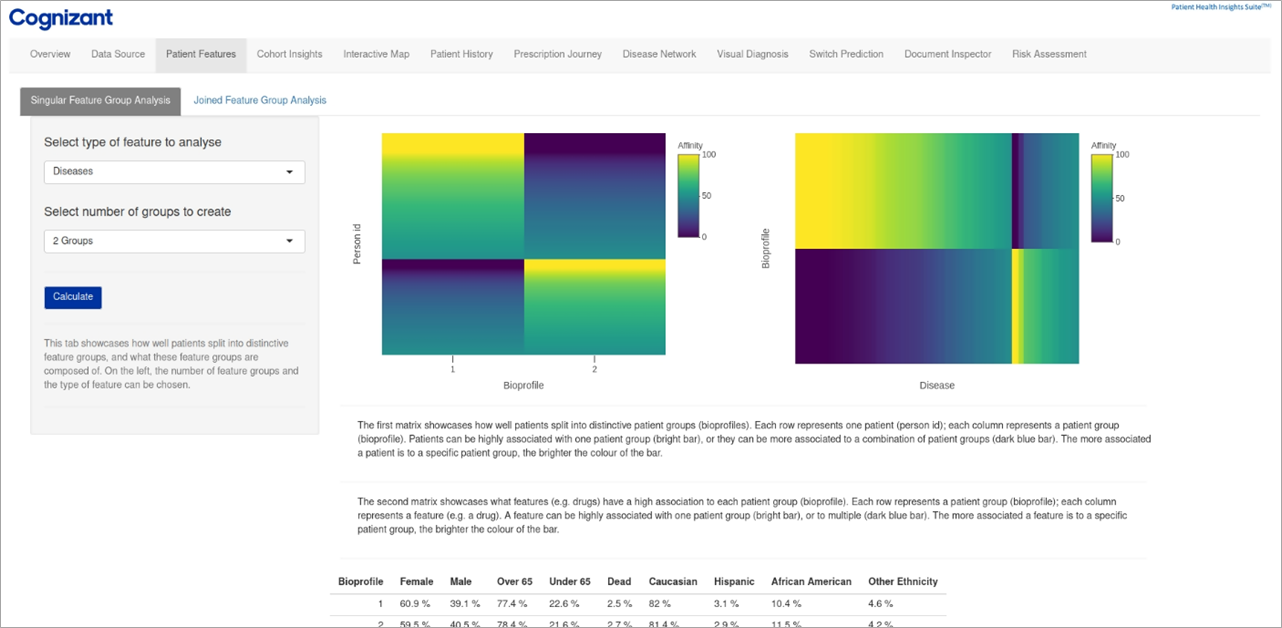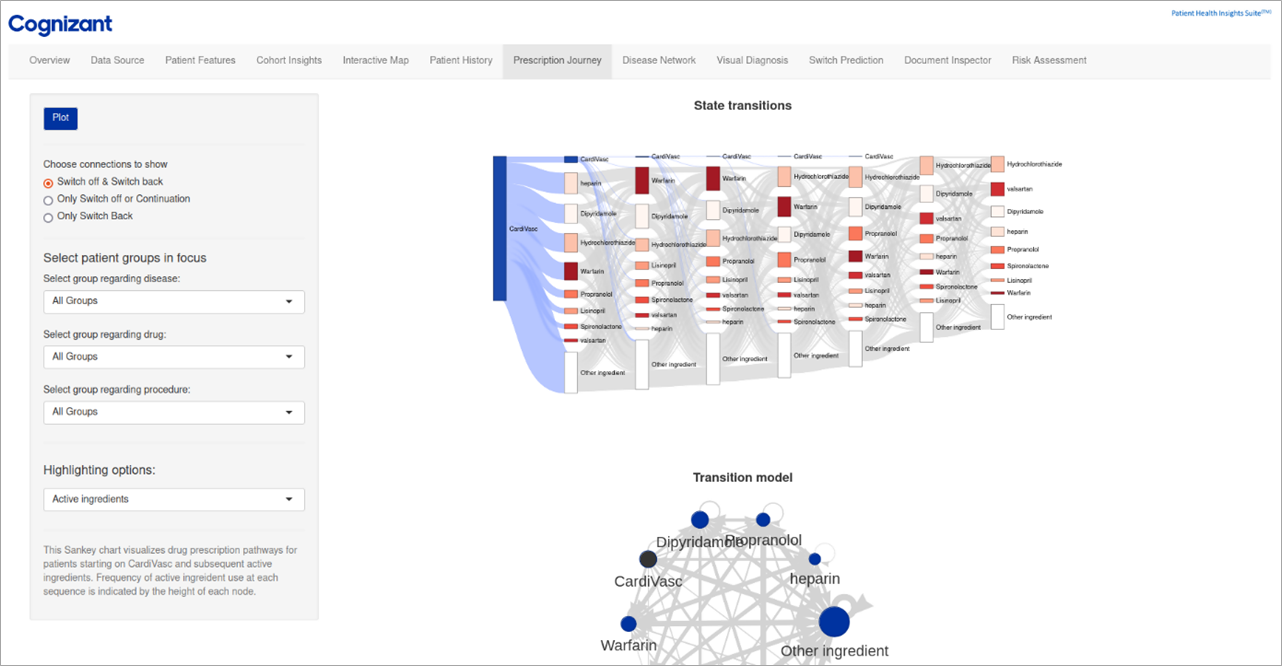AWS Partner Network (APN) Blog
Cognizant’s Patient Health Insights Suite is a Scalable Platform for Improving Healthcare
By Dr. Satish Gupta, Director AIA – Cognizant
By Saurabh Whadgar, Associate – Cognizant
By Priya Padate, Sr. Solutions Architect – AWS
 |
| Cognizant |
 |
Due to the rise of healthcare expenditures and increased wait times for medical care, early disease prevention has never been as important as it is today. Further, the increasing amount of healthcare data available increases the demand to develop an efficient, sensitive, and cost-effective solution for disease prevention.
Traditional preventive measures mainly focus on promotion of healthcare benefits and lack methods to process huge amounts of data. Cognizant’s Patient Health Insights Suite (PHIS) is a cloud-based, multi-user analytics and insights platform for clinical and real-world evidence data.
PHIS, hosted on Amazon Web Services (AWS), provides a suite of interactive self-service applications for comprehensive visual, exploratory, and predictive/prescriptive analyses of patient care and health insights by means of advanced artificial intelligence (AI) and machine learning (ML) algorithms.
Using the generated insights, the interactive applications offer new capabilities to scientists, clinicians, healthcare professionals, and service providers for knowledge discovery, computer-assisted diagnosis, and automated decision support in context of precision health and “P4 Medicine,” which stands for predictive, preventative, personalized, and participatory.
Patient Health Insights Suite facilitates ingesting and exploring a broad range of clinical and real-world observational health data including open-access, synthetic, and randomized patient treatment data, electronic medical records (EMR) or electronic health records (EHR), medical imaging data, laboratory test data, and de-identified patient information as required.
PHIS is a fully customizable, self-service platform that enables the generation, validation/confirmation, and collaboration of insights from various research study tracks using patient and observational health data. Customers can tailor and extend PHIS based on their intended use cases to deliver the desired analytics and insights. The platform’s modular architecture enables customers to combine many disparate tasks and functionality into a unified platform.
In this post, we demonstrate several benefits which customers can realize, including how PHIS can assist in early research and discovery to improve understanding of 1) disease associations and their progression; 2) markers for patient stratification and targeted therapies; and 3) drug dosing/treatment regime/healthcare service, all in context of P4 medicine and Precision health.
Cognizant is an AWS Premier Tier Services Partner and Managed Service Provider (MSP) that transforms customers’ business, operating, and technology models for the digital era by helping organizations envision, build, and run more innovative and efficient businesses.
Solution Overview
Patient Health Insights Suite enables various stakeholders across the healthcare ecosystem to work and collaborate on various precision health and P4 medicine-related patient care and health insights use cases (see exemplary use cases later in this post) via a suite of interactive applications running on the platform.
The PHIS architecture is designed to allow users to ingest various kinds of clinical and real-world evidence data sources into a data hub, extract relevant health information, and consolidate those via a common data model.
Users can simultaneously access shared and individual data partitions, create use cases related to feature sets, and generate distinct insights by running independent visual, exploratory, and predictive/prescriptive analyses through the various interactive applications. These insights are accessible across all applications by the same user and shareable among different collaborators.
The solution provides a comprehensive, powerful tool designed to deliver valuable insights and support decision making in the healthcare domain. The application is built on the Observational Medical Outcomes Partnership (OMOP) Common Data Model (CDM) database. OMOP CDM is an open community data standard designed to standardize the structure and content of observational data and enable efficient analyses that can produce reliable evidence.
PHIS allows users to connect and integrate a CDM database with multiple sources, including EMR, EHR, image, lab test, multi-omics, and high dimensions data into common data format. Additionally, observational health data sciences and informatics (OHDSI) data can be processed through an extract, transform, load (ETL) pipeline to transform and load raw data to OMOP format.
Figure 1 – PHIS high-level architecture.
PHIS encompass multiple sub-modules to cater to various analytics needs. Some of the key modules within PHIS are explained below.
Patient Stratification
The patient stratification module allows users to segment patient populations based on specific conditions. It provides visualization for each individual’s bio profile and its associativity with the group. The system also employs ML algorithms to identify distinct patient subgroups based on demographics and medical history.
This module uses the Non-Negative Matrix Factorization (NMF) algorithm to cluster the data based on user inputs and the underlying dataset. NMF is a decomposition technique for the analysis of high dimensional data to automatically extract sparse and meaningful features from a set of nonnegative data vectors.
Figure 2 – Bio profile plot and its associativity with the group.
Module Highlights:
- The result displays bio profiles of individuals based on selected feature(s) and cluster number.
- The first Bioprofile plot highlights how well patients split into distinctive patient groups, and the second Feature Association plot showcases what features (example: disease) have a high association to each patient group (bio profile).
Use Case:
- A major hospital network wanted to enhance patient care by tailoring treatments based on individual patient profiles.
Benefits:
- Enabled personalized treatment plans for patients, resulting in improved outcomes.
- Reduced hospital readmissions and optimized resource allocation.
- Facilitated more effective clinical trials by identifying suitable participants.
Prescription Journey
The Prescription Journey module leverages ML capabilities to provide a comprehensive view of prescription-related trends and patterns, and provides a detailed overview of patients’ medication history. This allows healthcare professionals to track treatment pathways and optimize therapies.
It also facilitates forecasting, analysis, and decision-making by visualizing the prescription journey for selected groups of individuals. Further, this module employs predictive analytics to project future prescription behaviors, offering insights into two key aspects: “Switch Off” and “Continuation” methods.
The module employs historical data to predict whether a patient will switch off a drug or continue its use. These predictions are presented through graphical representations, enabling healthcare professionals to understand trends and make informed decisions.
Figure 3 – Network graph reveals transitions in drug prescriptions.
Module Highlights:
- Upon making a choice, the user interface (UI) will present Sanky and Network plots. The Sanky plot provides an overview of group-based prescription journeys, arranging drugs chronologically, with band thickness indicating the number of individuals following the trend.
- The Network graph reveals transitions in drug prescriptions, with arrow direction signifying cessation or continuation post-prescribing a specific drug and arrow thickness denoting the probability of this shift. These visualizations enhance users’ grasp of prescription trends and how medications interconnect within patient groups, ultimately aiding informed decision making.
Use Cases:
- Treatment optimization: Healthcare providers can optimize treatment plans by identifying trends in prescription discontinuation and continuation patterns. This facilitates timely interventions and adjustments.
- Forecasting: The module assists in predicting prescription behaviors, enabling healthcare systems to anticipate and plan for potential changes in medication utilization.
- Pattern recognition: Researchers and analysts can identify patterns in prescription behaviors across populations, contributing to evidence-based medical research and policymaking.
Benefits:
- Proactive management: Helps healthcare professionals proactively address prescription discontinuation, potentially improving patient adherence and outcomes.
- Resource planning: Aids healthcare organizations in anticipating medication requirements, optimizing stock levels and managing costs.
- Enhanced patient care: Facilitates personalized care by enabling providers to tailor interventions based on projected prescription behavior.
Drug-Disease Network
The Disease-Drug Prediction module uncovers relationships between different diseases, aiding in understanding comorbidities and potential risk factors. The module provides an innovative toolkit to unravel the complex interplay between diseases and drugs.
Powered by AI-driven analytics, this module renders disease connections, disease-drug correlations, and their prevalence across varied patient clusters into insightful visuals. Presented through Circos diagrams, the visualizations holistically capture the landscape of disease incidences, their interactions, and the dynamic networks they form.
Figure 4 – Illustrates disease occurrences, co-occurrences, and network measures.
Module Highlights:
Leveraging a vast dataset, the Disease-Drug Prediction module employs sophisticated data analytics to establish connections between diseases and drugs. It examines the prevalence of these relationships across various patient groups.
The visual representation in Circos diagram format illustrates disease occurrences, co-occurrences, and network measures. This enables healthcare professionals to gain insights into disease patterns, potential associations, and patient groups with unique profiles.
Use Cases:
- Treatment insights: Healthcare providers can uncover potential disease-drug associations that may inform treatment decisions, leading to more personalized and effective interventions.
- Predictive analytics: The module can aid in predicting disease patterns and potential drug interventions based on historical data and associations.
Benefits:
- Holistic insights: Offers a comprehensive view of disease occurrences, co-occurrences, and their relationships with drugs, aiding in treatment strategies. Facilitates personalized patient care by identifying potential disease-drug associations and optimizing treatment plans.
Architecture
The PHIS solution at a high level is grouped into the following logical layers:
- Ingestion layer
- Landing/storage layer
- Data transformation layer
- Business layer
- Consumption layer
Figure 5 – PHIS reference architecture.
- In the healthcare setting, data sources can include various sources like clinical reports, claims data, imaging, EMR, multi-omics, and more. The source data could be on-premises or on the cloud. For insights generation, the data will be transferred to the cloud by means of upstream integration to the PHIS platform.
- The data ingestion can be batch, near real-time, or streaming based on need of the data provider, and can vary based on the use case. For example, either AWS DataSync or AWS Transfer Family can be used for transfer. In either case, the data is transferred securely with encryption during transit and at rest.
- The landing layer has raw datasets received from source systems that are stored in the raw data layer in the source format on Amazon Simple Storage Service (Amazon S3). By running OHDSI-ETL workflows, the data is converted to OMOP format and stored in the Amazon RDS for PostgreSQL.
- The R scripts runs against the OMOP common data model and generates intermediate files with the preprocessing done ahead of time. The data transformation layer is primarily responsible to create business terms for data elements in the system.
- Technical metadata should be linked to the business, which involves data wrangling to standardize data to models, information extraction, image processing, and natural language processing (NLP).
- The data storage layer data shall be based on the consumption pattern of the consumers. Purpose-built data stores will be storing curated data for downstream consumption.
- In the business layer, end users can query structured claims data and create data products that can be consumed by care management to provide more efficient operational analysis and improved clinical insights. Analytical models, standard reports, and dashboards will be deployed to visualize study performance. Based on the use case, Amazon QuickSight or Amazon Athena are used for providing insights. For deeper AI-based insights, Amazon SageMaker is leveraged with appropriate models.
- The consumer layer will provide business users, researchers, data scientists, and technical users the means to view and modify datasets and pre-existing content and even create new content. It can be modified to enable sharing and collaboration.
- The overall data security, compliance, and governance is handled at the solution level by a set of purpose-built AWS services as called mentioned in the data security layer.
Conclusion
By adopting Patient Health Insights Suite, healthcare organizations and the research community can realize the benefits of a flexible, scalable, and accessible self-service platform. This solution fulfills their needs for generating, validating, and collaborating on insights from different research study tracks using patient and observational health data.
PHIS can help scientists, clinicians, and healthcare professionals involved in early research and healthcare services across a wide range of use cases. Ultimately, PHIS provides the foundation to help healthcare and research organizations deliver improved disease (progression) prevention and treatments therapies to drive better health outcomes for their patients.
Cognizant – AWS Partner Spotlight
Cognizant is an AWS Premier Tier Services Partner and MSP that transforms customers’ business, operating, and technology models for the digital era by helping organizations envision, build, and run more innovative and efficient businesses.





